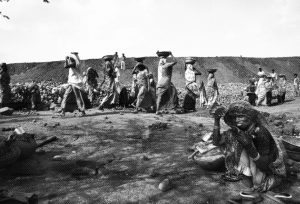 The government’s flagship programme to alleviate rural poverty-the Mahatma Gandhi National Rural Employment Guarantee Scheme, which was gasping for funds in view of cut in its budget, has actually come in handy to help out migrants moving who have returned to their native states. During 2019-20, MGNREGA was allocated `60,000 crores which was even less than the amount of `61,084 crores (revised estimate) earmarked for the scheme in the previous year of 2018-19.
The government’s flagship programme to alleviate rural poverty-the Mahatma Gandhi National Rural Employment Guarantee Scheme, which was gasping for funds in view of cut in its budget, has actually come in handy to help out migrants moving who have returned to their native states. During 2019-20, MGNREGA was allocated `60,000 crores which was even less than the amount of `61,084 crores (revised estimate) earmarked for the scheme in the previous year of 2018-19.
In an OPED piece that Congress Acting President Sonia Gandhi’s Communication Department sent to media houses, it claimed that “the Mahatma Gandhi National Rural Employment Guarantee Act (MGNREGA), 2005 is a shining example of a radical and rational systemic change. It is radical because it transferred power to the poorest of the poor and enabled them to escape hunger and deprivation. It is rational because it puts money directly in the hands of those who need it most. It has proved its worth in the years it has been in existence, even enduring six years of a hostile government”.
It claimed that a government that sought to denigrate it, undermine it has come to reluctantly rely on it. Along with the Public Distribution System put in place earlier, it is the mainstay for our poorest and most vulnerable citizens in preventing starvation and destitution wherever implemented in letter and spirit, especially in today’s COVID-19 crisis. “Let us not forget that the notification of MGNREGA in September 2005 as an Act of Parliament came about because of a people’s movement after years of struggle by civil society”.
The idea was simple: any citizen in rural India now had the legal right to demand work and guaranteed 100 days of work with minimum wages provided by the government. And it proved its worth very quickly, a grassroots, demand-driven, Right to Work programme, unprecedented in its scale and architecture, focused on poverty alleviation. Millions have been saved from hunger and worse in the 15 years since its inception.
The COVID-19 pandemic and the distress it has unleashed, has brought the government around full circle. Faced with unprecedented hardship and an economy already in slowdown, the government was obliged to fall back on UPA’s flagship rural relief programme. Deeds are more important than words, and nothing speaks more eloquently than the Finance Minister’s recent and belated increase in the overall allocation of the programme to more than `1 lakh crore.
In May 2020 alone 2.19 crore households demanded work through the Act, the highest for the month in eight years. As dejected workers return from cities and towns to their villages in droves, deprived of employment, facing an insecure future, a humanitarian crisis on an unprecedented scale unfolded. And the value of MGNREGA has never been clearer and more evident.
Tehelka had done a story “Ailing MGNREGA” in February 2020 issue that the budgetary allocation for MGNREGA had come down in 2019-20. A year before that it had increased to `61,084 crore in 2018-19 from `34,000 crore in 2014-15. Except for 2014-15, in all years since then, actual expenditure has been more than the approved budgetary allocation. According to the non-profit Centre for Budget and Governance accountability, “The allocations have actually declined when adjusted for inflation.”
Little doubt that the Centre was running out of funds for the MGNREGA scheme because by January 2020, more than 96 per cent of the allocated funds had already been exhausted by the States. Reason the MGNREGA had for the first time in five years, been allocated less budget that the previous year’s actual expenditure. In the Budget 2019-20, MGNREGA was allocated `60,000 crores as against `61,084 crores during the previous year.
Since its inception, the actual expenditure has been more than the approved budgetary allocation for this scheme for all states and union territories. For instance for 2011-12, the budget allocation for all states and union territories was `31,000.00 crores but actual expenditure was `37,072.82 crores. Similarly for 2012-13, the allocation was `30,387 crores but expenditure was `39,778.29 crores. During 2013-14, the scheme was allocated `33,000 crores but expenditure was `38,511.10 crores.
The allocation remained static at `33,000 crores for 2014-15 as against expenditure later at `36,025.04 crores. For 2016-17, the budget for this scheme was raised to `48,220.26 crores but actual expenditure went up to `57,946.72 crores. A year later in 2017-18, the allocation came down to `48,000 crores. In 2018-19, budget allocation was raised to `61,084 crores (revised estimates). The expenditure statement is yet not available for these years but the fact that majority of funds have already been exhausted shows that fund crunch has hit the scheme hard.
According to the non-profit Centre for Budget and Governance accountability, “The allocations had actually declined when adjusted for inflation.” The government has to allocate more funds if the Budget provisions are not adequate to meet demand for jobs since this is a demand-driven and legislated programme. It generated 267.96 crore person days during 2018-19.
The overall allocation for the Ministry of Rural Development has increased by `5,200 crores than last year. The total allocation for last financial year, was `1,17,647 crores, the same as was proposed in the interim budget. In the 2018-19 Budget, it was `1,12,404 crores. But the fact remains that though the allocation for the ministry has been increasing over the years, its share in the total Budget has decreased to 4.4 per cent in 2019-20 from 4.7 per cent in 2018-19.
 It is said that at times the figures don’t tell the story. The government had claimed that the allocation of `61,084 crores for MGNREGA was all time high. A release by the Press Information Bureau had claimed that the Government of India had allocated an additional `6,084 crores at the stage of revised estimates to MGNREGA. It had claimed that this brings the total allocation to the scheme to `61,084 crores in 2018-19, making it the highest ever allocation. Governance reforms and thrust on sustainable livelihoods through durable assets has ensured better lives for the poor through wages, incomes and durable assets.
It is said that at times the figures don’t tell the story. The government had claimed that the allocation of `61,084 crores for MGNREGA was all time high. A release by the Press Information Bureau had claimed that the Government of India had allocated an additional `6,084 crores at the stage of revised estimates to MGNREGA. It had claimed that this brings the total allocation to the scheme to `61,084 crores in 2018-19, making it the highest ever allocation. Governance reforms and thrust on sustainable livelihoods through durable assets has ensured better lives for the poor through wages, incomes and durable assets.
The MGNREGA is a flagship programme of the Ministry, which addresses poverty in a holistic manner by overcoming social inequalities and creating a base for sustainable & long term development. In fact the MGNREGA is transforming rural India into a more productive, equitable and connected society. It has provided nearly 235 crore person days in the last three years, each year. This year as well, it will be around the same making it four years of consistent high performance on wage employment with durable assets for sustainable livelihoods.
The government claimed that over the last four years, the Ministry of Rural Development had completed major reforms in the MGNREGA to transform it into a resource for sustainable livelihoods for the poor. Generation of payments within 15 days was done only in 26.85 per cent cases in 2014-15 and barely 29.44 lakh assets were completed in that year. A systematic nationwide exercise was initiated for plugging these gaps in partnership with States.
There has been a remarkable increasing trend in the budget allocation of the Central Government and release for the programme from `32,977 crores in financial year 2014-15 to `55,167 crores in the financial year 2017-18. This is a clear evidence of the increasing faith of the people in the programme. The MGNREGS witnessed a record expenditure of `63,644 crores in 2017-18 including state share, the highest since the programme was launched. Since, the issue of creation of durable assets was considered very important, the 60:40 ratio was mandated at Gram Panchayat level often leading to non-productive asset being created simply because 60 per cent had to be spent on unskilled wage labour in that Gram Panchayat. Without diluting the 60:40 principle, the first big reform was to allow 60:40 at the District level rather than at the Gram Panchayat level. In spite of this reform, the ratio of expenditure on unskilled wage labour to overall expenditure remains higher than 65 per cent. This has enabled a new thrust on durable assets that generate incomes. It allows the flexibility to undertake only those assets that are productive.
Over 60 per cent of the resources are spent on Natural Resource Management (NRM). The NRM works are focused on ensuring higher incomes to farmers by improving both the area under cultivation and yield of crops. This is done by improving the productivity of land and increasing the water availability. The major works taken up under NRM include check dam, ponds, renovation of traditional water bodies, land development, embankment, field bunds, field channels, plantations, contour trenches etc. During the last 4 years 143 lakh hectares of land benefitted through these interventions. Large scale water conservation, river rejuvenation, and irrigation works have been taken up and completed under MGNREGA.
Another major thrust of the last four years has been creation of durable community and individual beneficiary assets. A very large number of Individual Beneficiary Schemes like goat sheds, dairy sheds, 90-95 days work, wells, farm ponds, vermi-compost pits, water soak pits etc. have also been taken up over the last 4 years. These assets have helped the under privileged to have access to alternative sustainable livelihood. Similarly, building of Anganwadi Centers (AWC) has been a significant effort towards creation of durable community assets. The AWCs act as a hub for the care and development of young children where the working mothers can also leave their children behind while they seek work. Nearly 1,11,000 AWCs are being constructed in convergence with MWCD. Solid Waste Management works have also been taken up on a large scale leading to cleaner villages, higher incomes, and more diversified livelihoods for the poor. All this is being possible by permitting 60:40 at the District level rather than at the Gram Panchayat level. The commitment to unskilled wage labour has not declined at all in spite of a thrust on durable assets that are income generating and livelihood diversifying.
The generation of person days each year is a reflection on the thrust for wage labour. Since 2015-16 to 2018-19 so far, the demand for work has been high with average 235 crore person days generation annually in the last 3 years and even this year being no different. These numbers compare very well with almost every year in the past except 2009-10, which was a year of severe drought. The linkage of MGNREGS with women SHGs, infrastructure for Deen Dayal Antyodaya Yojana-National Rural Livelihood Mission (DAY-NRLM) activities has also supplemented incomes of very poor households. The skill development opportunities for MGNREGS workers to become certified rural masons, barefoot technicians or in other skill programmes of Deen Dayal Upadhyaya Grameen Kaushalya Yojana (DDU-GKY) and Rural Self Employment Training Institutes (RSETIs) makes a difference to poverty in the long run.
The focus is on the diversification of the livelihoods with multiple sources of income for them to come out of poverty. The expansion of the women Self Help Groups movement under DAY-NRLM from less than three crores to nearly six crores membership has happened during the same period during which MGNREGA was being fully reformed to deliver employment, durable assets and sustainable livelihoods. The generation of payment within 15 days has moved up from 26 per cent in 2014-15 to 91 per cent in the current, confirming the governance reforms that have made this possible.
The National Evaluation Study of the Natural Resource Management interventions of MGNREGA in 2018 by the Institute of Economic Growth New Delhi, confirmed the gains in incomes, acreage, productivity, water table and fodder availability on account of the NRM works. In that evaluation 99.5 per cent assets were found to be very good/good/satisfactory, a proxy for the success of the governance reforms undertaken.
Admittedly there are gains in incomes of individuals but in view of more expenditure in comparison to budget allocation, at least 15 states have negative balance currently. The highest negative balance is in case of Rajasthan at `620 crores, followed by Uttar Pradesh with a negative balance of `323 crores. The ambitious MGNREGA has pushed up rural wages and incomes and has also created rural infrastructure and provided much-needed employment to the country’s rural population. However, it has been unable to provide a stimulus to the rural economy because funds allocation has not kept pace with rising inflation and growing demand because labour migration has come down resulting in more funds to provide guaranteed employment.
Now it is being realized that MGNREGA is once again going to prove to be a new lifeline for migrate workers as the Uttar Pradesh government has envisaged to create 5 million jobs per day under the scheme giving it a major thrust. Massive inflow of migrants into the Uttar Pradesh due to loss of jobs during lockdown has brought the spotlight on resultant unemployment of a big workforce in already overstressed state on this front.
Uttar Pradesh alone anticipates enhancement of MGNREGA jobs from the current tally of 2.63 million to 5 million a day. However, the ill-fated scheme has seen so many ups and downs with big scams and involvement and connivance of high profile bureaucrats to usurp hard-earned public funds allocated for various rural development projects during the rules of BSP, SP and now BJP. Even the High Court monitored CBI investigations could not see the light of trials due to non-availability of prosecution sanction stuck in bureaucratic somersaulting despite big claims of zero tolerance on corruption by present regime.
The unprecedented flood of migrant workers to their native villages in Uttar Pradesh would cost heavily on the economic growth of rich states like Maharashtra, Gujarat and Punjab. The government is well conscious of the facts that it has to face the real brunt of the influx in terms of heavy loss in the industrial, infrastructural, real estate and agriculture sectors. The migrant workers use to be lifeline of these states for production, infrastructural and industrial development who have deserted experiencing extremely difficult for their survival without food and money.
 Little doubt that the Finance Minister Nirmala Sitharaman has announced an additional funding of `40,000 crore to the MGNREGA schemes over and above the Budgetary Estimate. Soon after the lockdown the Central government had already released payment of Rs.1538,29 as 1st installment of 1st tranche of Central Assistance Grants-in-aid for financial year 2020-21 towards wage component to the state which has earmarked `8400 crore for the current fiscal year. Under recently announced additional special package the state anticipates to get around `5800 crores more than earlier allocation. The state government transferred `225.39 crore to clear pending wages of the beneficiaries of the MGNREGA schemes through direct bank transfer.
Little doubt that the Finance Minister Nirmala Sitharaman has announced an additional funding of `40,000 crore to the MGNREGA schemes over and above the Budgetary Estimate. Soon after the lockdown the Central government had already released payment of Rs.1538,29 as 1st installment of 1st tranche of Central Assistance Grants-in-aid for financial year 2020-21 towards wage component to the state which has earmarked `8400 crore for the current fiscal year. Under recently announced additional special package the state anticipates to get around `5800 crores more than earlier allocation. The state government transferred `225.39 crore to clear pending wages of the beneficiaries of the MGNREGA schemes through direct bank transfer.
“Current economic measures announced by the Modi Government should also include immediate monetary plan so that at least migrants get purchasing power in their hands which will create demand and eventually supply which will boost the economy,” advised former IAS Narendra Nath Verma who has vast experience in the field of Rural Development and MSME sectors. Verma was instrumental in conceiving plan and acquisition of land at the time of creation of NOIDA industrial area as a hub of integrated industrial growth. The 2011 census records show that the Hindi heartland states, including Uttar Pradesh, Bihar, Rajasthan and Madhya Pradesh contribute for 50 per cent of India’s total interstate migrants. The UP remained the biggest source of out-migrants as together with Bihar account for 37 per cent. So experts feel that desperate migrant workers will never muster courage to go back there after their terrific horrifying and tragic experiences due to sudden lockdown that forced them to walk on the roads finding no other way of survival. It is in this scenario that MGNREGA comes as the best bet!
letters@tehelka.com













